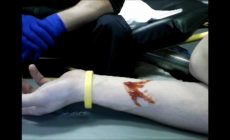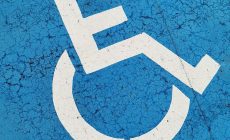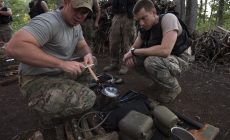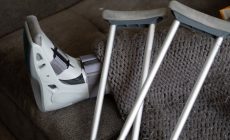Learn Basic First Aid
Knowing how to administer basic first aid is very important in a survival situation and can mean the difference between life and death. You have to keep in mind that in a survival situation getting professional medical help may be impossible so knowing the right first aid skills will greatly increase you and your family’s chances of survival. You might want to install some health care apps right now and check them, just in case anything go wrong.
Knowing how to administer properly, presence of mingoesand quick action are the main factors of a successful first aid. Keep in mind that knowing what you need to do in an emergency situation and not being afraid to act will help you administer efficient first aid properly. Here are some basic first aid skills that can be very useful to add on your list survival skills:
1. Cleaning and Dressing Wounds
In a survival situation Gashes, scrapes, and cuts might be an avoidable injury. Having the right skill to properly disinfect and bandage wounds aside from having the best first aid kit is really important. It is not enough to just slap on a bandage, first thing you need to do is to determine how big the wound is. Bigger wounds will always cause bleeding so it is important to stop the bleeding first. This can be done by lifting the body part where the wound is on above the heart’s level in order for the blood to flow away from the wound and downwards. Another effective way to stop a bleeding is by applying pressure. When the bleeding has stopped the next things you need to do is clean and disinfect the wound to avoid infections. Using a disinfectant or warm water can also prevent complications. Watch this video on how to properly clean and dress wounds:
2. Making a Makeshift Splint or Sling
One of the most important first aid skills to learn would be making your own makeshift splints or slings for broken bones. Broken bones and sprains are inevitable injuries that need first aid especially in a outdoor survival or emergency situation, the main key to a fast recovery would be protecting and avoiding further damage by completely immobilizing the part where the injury is. By creating a sling or splint you will be able to move your patient safely and faster. Everyday objects can be used as splints as long as it is hard and straight. Watch this short video on how to make slings for first aid:
3. CPR
CPR or cardiopulmonary resuscitation is one of the most important first aid skills which are used to help victims with cardiac arrest. Cardiac arrest could be fatal and would certainly result to death of a victim if not treated with CPR as the heart stops pumping blood. Here are the proper steps on how to do CPR efficiently:
- Begin Chest Compressions
The first thing you need to check if the victim is still breathing, if the victim has stopped breathing put the heel of your hand in the middle of the victim’s chest with your other hand on top of the other interlacing your fingers. Compress the chest at least 2 inches but remember to allow the chest to completely recoil before doing the next compression. At a rate of at least 100 pushes per minute continue to compress the chest. You may feel snaps and pops at the beginning of your chest compressions which is normal.
- Begin Rescue Breathing
After 30 compressions you need to open the victim’s airway by using the head-tilt, chin-lift method. Pinch the victim’s nose to prevent air from escaping and make a seal over the victim’s mouth with yours. Give the victim a big breath enough to make his chest rise. Wait for the victim’s chest to fall before repeating the rescue breath. If you notice that the chest is not rising just reposition the victim’s head and try it again.
- Repeat Chest Compressions
Do another 30 chest compressions after doing the rescue breathing.
- Repeat Rescue Breathing
Just like you did before, give 2 more rescue breaths.
- Keep Going
Keep doing steps four and five for about two minutes which is about 5 cycles of 30 compressions and 2 rescue breaths.
- Check for Breathing Response
Recheck the victim’s breathing after continuous chest compressions and rescue breaths for 2 minutes. If the victim is breathing you can stop administering CPR, if the victim is still not breathing continue CPR starting with chest compressions.
Watch this short video to learn how to administer proper CPR:
4. Heimlich Maneuver
The Heimlich maneuver is a very useful first aid skill that is performed to help victims that are choking. By performing abdominal thrusts to the victim you can expel objects that are blocking the victim’s airway. Doing the proper method and applying the right force when doing the Heimlich maneuver is very important to avoid causing injuries. Watch this short video tutorial on how to administer the Heimlich maneuver properly and effectively:
5. Treating Shock
Too much blood loss will result to a drop in blood pressure. Very low blood pressure can be very fatal and could kill a person in just a few minutes, if you were unsuccessful in stopping the bleeding then you need to administer shock treatment if necessary. Follow these steps on how to effectively administer shock treatment:
- Laying the victim down properly
Lay the victim on his or her back and raise the victim’s feet at least a foot higher than the head. If raising the victim’s legs will cause further injury or pain keep the person till.
- Check for Signs of Circulation
Check and make sure if the victim is breathing or showing coughing signs, if not you need to apply CPR immediately.
- Keep the Victim Warm and Comfortable
Loosen any belts and tight clothing and cover the victim with a blanket to keep him warm and comfortable. Remember not to give the anything to the person by mouth even if the victim complains of thirst to avoid chocking and blocking the victim’s air passage.
- Prevent choking
If the victim is vomiting or bleeding from the mouth it is important to make sure that the victim’s airway will not be blocked so you need to turn the victim on his or her side.
- Treat Injuries Immediately
If the victim sustained any injuries like broken bones and wounds you need to stop the bleeding immediately and apply necessary first aid to prevent any complications and bring immediate relief.
Watch this video tutorial on how to give first aid to a victim going into shock:
Learn more from this First Aid Centre in Ottawa.

























5 Comments
packers makers
April 9, 2019 - 10:58 amCPR or cardiopulmonary resuscitation is one of the most important first aid skills which are used to help victims with cardiac arrest (True) I agree with that
really good blog and really helpful.
Steve
April 9, 2019 - 11:50 amMost of the people not aware about First Aid Skills, First Aid Skills save anybodies life is we know about that. Thanks for sharing such a good information. I appreciate your thought and views.
Steve
April 17, 2019 - 11:10 amThanks for sharing such a good blog. I appreciate your thought and views.
JamesSmith
August 7, 2019 - 9:40 amgood post! Canadian Oil and gas agree with – this is an organization that invests in oil and/or gasoline production and possibly mining in Canada. Several of those at the moment are buying and selling on the yank (US) exchanges. Buy is the same as buying a stock in every other corporation. Tax advantages are much like the ones of an REIT and a massive gain – the one I just like the most – is that some of these trusts pay ridiculously excessive dividends – and they pay monthly! My recommendation: do your research, discover a Canadian Oil and gas consider you want and then invest as a lot as you could.
Alice Carroll
May 16, 2022 - 8:19 amThanks for the reminder that it’s also essential to clean wound properly when planning to get first aid done. I’d like to know more about level 3 first aid practitioners because I am currently making a list of contacts for emergencies for my business. First aid responders would surely be a high priority to include there right away.